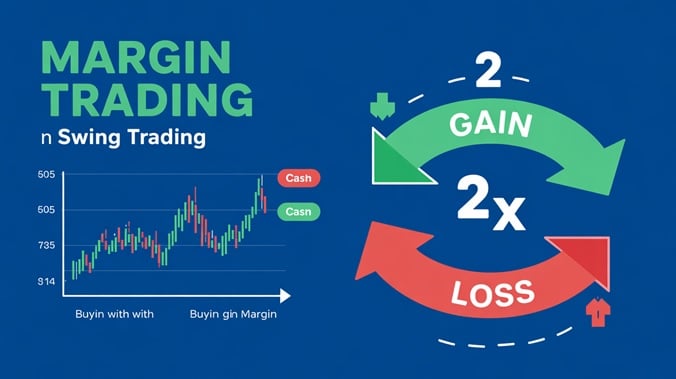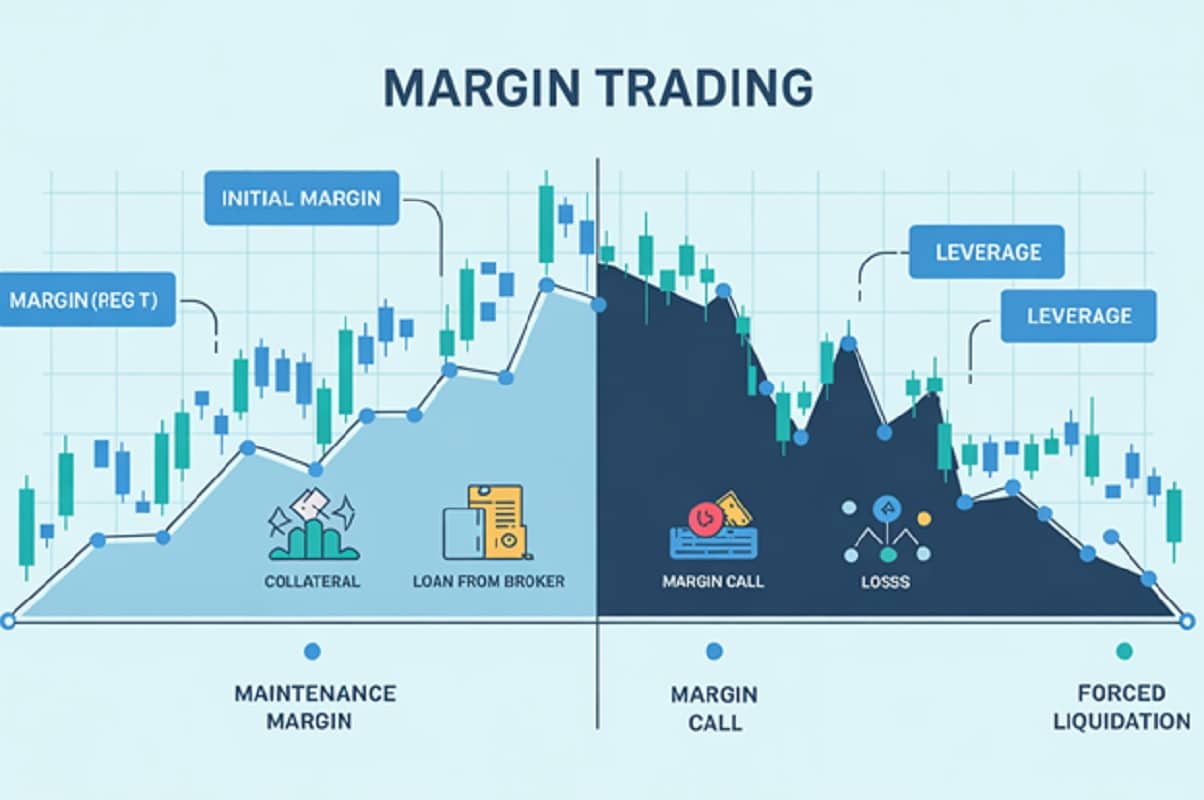Margin trading is like using your broker’s credit card to buy stocks. You put down some cash (your “collateral”), and they lend you the rest. Example: Drop 5k of your own money, another 5k from the broker, and suddenly you’re playing with 10k in stocks. If those stocks increase in value by 2x, you’ll have made $1,000 instead of $5,000. Sweet, right?
But here’s the catch: leverage is a double-edged sword. If the stock drops 20%, you lose 40%. And if it crashes harder? The broker will hit you with a margin call: “Pay up now, or we’ll sell your stocks at a loss to cover our loan.”
This isn’t Monopoly money. Real-world meltdowns—like the 1929 crash (where margin debt fueled the boom and the bust) or the Long-Term Capital Management (LTCM) hedge fund blowup in 1998—show how borrowed cash can turn a bad trade into a disaster.
The Gateway: Opening and Understanding Your Margin Account
Margin trading requires a specific margin account, distinct from a standard cash account.
Margin Account vs. Cash Account: A cash account requires full payment for securities using settled funds. Trading is limited by the cash balance. A margin account allows borrowing against account assets (cash and securities). This enables leverage but introduces debt risks.
Cash trading limits losses to the invested amount; margin trading risks losses greater than the initial deposit. Strategies like short selling require a margin account.
The Margin Agreement: Opening a margin account requires signing a margin agreement, a binding contract detailing the loan terms. It covers interest calculation, repayment obligations, and the use of securities as collateral.
Crucially, it outlines the broker’s right to sell securities (forced liquidation) to cover margin deficiencies, often without notice. It also specifies adherence to margin rules from regulators (Federal Reserve, FINRA) and the firm’s “house” rules. Investors must fully understand this agreement before trading, as it prioritizes the broker’s protection.
Suitability Requirements (FINRA Rule 2111): Before opening a margin account, firms must assess if margin trading is suitable for the client under FINRA Rule 2111. This involves evaluating the customer’s investment profile (age, finances, objectives, experience, risk tolerance, etc.). The firm must reasonably believe margin trading aligns with the profile and the client can handle the risks. Recommending margin solely for commissions violates this rule. Brokers must also disclose margin risks clearly.
Minimum Equity Requirements: FINRA requires a minimum deposit of $2,000 or 100% of the purchase price (whichever is less) before the first margin trade. Many firms require more. This is a baseline; practical margin use depends on meeting initial margin requirements for trades. “Pattern day traders” (often 4+ day trades in 5 days) need a $25,000 minimum equity.

The Mechanics of Margin Trading: Leverage, Costs, and Calculations
Understanding margin rules and calculations is vital for managing risk.
Initial Margin (Regulation T): Regulation T (Reg T) from the Federal Reserve governs the initial credit extension. For most stocks, Reg T sets a 50% initial margin. Investors must contribute at least 50% of the purchase price, borrowing up to 50% from the broker. Buying $20,000 of stock requires depositing $10,000. Firms can set higher requirements. Some securities (certain OTC stocks, recent IPOs, short-term options) are not marginable.
Maintenance Margin: After purchase, accounts are subject to maintenance margin: the minimum equity percentage required relative to the current market value. FINRA Rule 4210 sets the minimum at 25% for long stocks.
Broker “House” Requirements: Crucially, brokers impose stricter “house” maintenance margins, often 30-40% or higher, especially for volatile stocks. These supersede FINRA minimums and can be increased by the broker anytime without prior notice. The difference between initial and maintenance margin is the buffer against market declines, but this buffer can shrink quickly due to volatility or changes in house rules.
Leverage in Action (Examples):
- Gain: Deposit $10,000, buy $20,000 stock (50% margin). Stock rises 20% to $24,000. Equity becomes $14,000 ($24k value – $10k loan). $4,000 gain is 40% return on $10,000 investment (vs. 20% cash-only).
- Loss: Same setup, stock falls 20% to $16,000. Equity falls to $6,000 ($16k value – $10k loan). $4,000 loss is 40% loss on $10,000 investment (vs. 20% cash-only). If house maintenance is 30% ($4,800 needed), no margin call yet, but buffer reduced.
Special Memorandum Account (SMA): SMA tracks excess equity above the 50% Reg T requirement, acting like a line of credit. SMA increases with market value rises, cash deposits, dividends/interest received, or sale proceeds. Buying power is typically twice the SMA balance, allowing new margin purchases without new funds. Once generated, SMA doesn’t decrease if market value later falls, locking in buying power. However, using SMA reduces the equity buffer above maintenance margin, increasing leverage and risk. SMA generally cannot meet a maintenance margin call.
The Danger Zone: Margin Calls and Forced Liquidation
Margin trading’s primary risks involve margin calls and potential forced liquidation.
Triggering a Margin Call: A margin call is a broker’s demand to increase account equity. It occurs when equity falls below the required maintenance margin (FINRA’s 25% or the broker’s higher house level). This usually happens when margined securities decline in value, but can also be triggered by increased house requirements or over-trading.
Meeting the Call: Investors typically have a short time (2-5 days, maybe less) to meet the call by :
- Depositing cash.
- Depositing additional marginable securities (need higher value than cash call).
- Liquidating positions to reduce the loan and increase equity percentage.
Forced Liquidation – The Broker’s Right: Failure to meet a margin call allows the broker to forcibly sell securities in the account. Key points:
- No Prior Notice Required: Brokers generally don’t have to notify investors before liquidating, though many try.
- Immediate Action Possible: Brokers can liquidate immediately if needed to protect themselves, even if a deadline was given. Control shifts to the broker.
- Broker Selects Securities: The broker, not the investor, chooses which assets to sell.
- Potential Overselling: The firm might sell more securities than needed to meet the call, possibly covering the entire loan.
Consequences of Liquidation: The investor bears all losses from forced liquidation, including commissions. If sale proceeds don’t cover the loan and deficit, the investor owes the difference. Liquidations often happen at bad prices during downturns, locking in losses. Widespread margin calls can worsen market declines.
Weighing the Scales: Advantages and Disadvantages of Margin Trading
Margin trading offers potential benefits but carries significant drawbacks.
Potential Benefits:
- Increased Purchasing Power/Leverage: Amplify potential returns by controlling larger positions.
- Flexibility: Act on opportunities quickly without depositing new funds.
- Diversification: Potentially achieve broader diversification.
- Short Selling: Enables short selling strategies.
- Cash Withdrawals: Possible to borrow against equity for short-term needs (increases risk).
Significant Risks & Disadvantages:
- Magnified Losses: Leverage amplifies losses, potentially exceeding initial capital.
- Interest Costs: Ongoing expense reduces returns or increases losses, regardless of performance. Unsuitable for long-term buy-and-hold.
- Margin Call Risk: Constant risk of needing to deposit funds quickly if equity drops. Can lead to emotional decisions.
- Forced Liquidation Risk: Broker can sell assets without consent if call isn’t met, often at unfavorable prices.
- Increased Volatility Sensitivity: Leverage makes account value more susceptible to market swings.
- Complexity & Monitoring: Requires understanding complex rules and diligent monitoring.
Beyond Basic Buying: Advanced Margin Account Uses
Margin accounts enable strategies like short selling and hedging.
Short Selling: Short selling aims to profit from a price decline and requires a margin account. Process involves borrowing shares, selling them, hoping the price drops, buying them back cheaper, and returning them to the lender. The broker must locate shares before the sale (Reg SHO). Margin requirements apply: Reg T requires 150% of the short sale value initially (100% proceeds + 50% additional margin). FINRA’s $2,000 minimum equity also applies. Maintenance margin is required, often 30% or higher based on price/house rules. The main risk is potentially unlimited loss if the price rises instead of falls. Rising prices can cause margin calls or a “short squeeze.” Borrowing costs also apply.
Hedging Strategies: Hedging aims to reduce potential losses in an existing position by taking an offsetting one, often using derivatives in a margin account.
- Protective Puts: Buying put options on a stock you own gives the right to sell at a set price, limiting downside loss. The cost is the option premium. While buying options doesn’t usually need margin, complex option strategies often do.
- Futures Hedging: Using futures contracts to lock in prices for commodities, currencies, etc. For example, a farmer selling grain futures or an airline buying oil futures. Futures trading has its own margin rules. Hedging involves costs and complexity, and effectiveness isn’t guaranteed.
Margin trading is a powerful tool offering amplified returns and flexibility, but it comes with magnified risks. Leverage enhances gains but equally boosts losses, potentially exceeding the initial investment.
Success requires understanding the mechanics (initial/maintenance margin, house rules, interest costs, SMA) and dangers (margin calls, forced liquidation). The broker’s right to liquidate assets without notice during market stress is a critical risk.
Margin trading is suitable only for experienced investors with high risk tolerance, market knowledge, and the financial capacity for substantial losses. Robust risk management—monitoring equity, using stop-losses, diversifying, managing position size—is essential. It’s generally ill-suited for long-term buy-and-hold strategies due to interest costs. Prudence and diligence are crucial when using margin.
Frequently Asked Questions (FAQ)
What is margin trading?
Margin trading is borrowing money from a broker to purchase financial assets, using securities in your account as collateral. It uses leverage to control larger positions, magnifying potential profits and losses.
What’s the difference between initial and maintenance margin?
Initial margin is the minimum percentage you pay upfront when buying on margin (typically 50% for stocks via Reg T). Maintenance margin is the minimum equity percentage you must keep in the account afterward (FINRA minimum 25%, brokers often require 30%+).
What is a margin call?
A demand from your broker to add equity (cash or securities) to your account when its value falls below the maintenance margin level, often due to declining security prices.
Can I lose more than my initial investment?
Yes. Leverage magnifies losses. If margined securities drop significantly, losses can exceed your initial deposit.
What happens if I can’t meet a margin call?
Your broker can forcibly sell securities in your account (forced liquidation) without your consent to cover the deficiency. You are responsible for any losses and remaining debt.
































